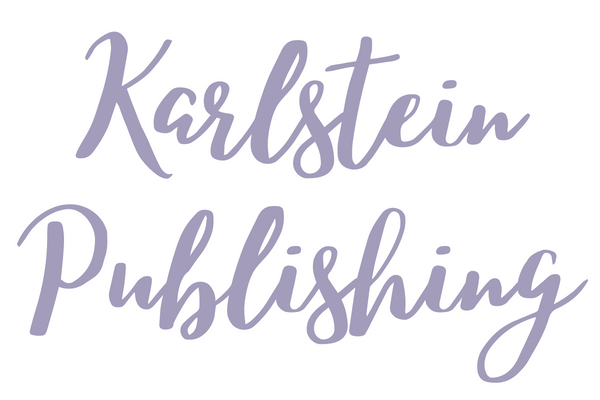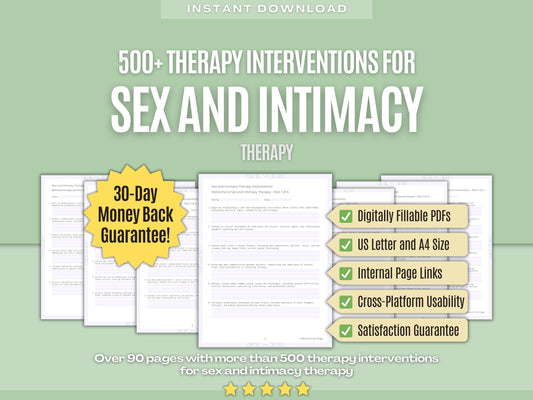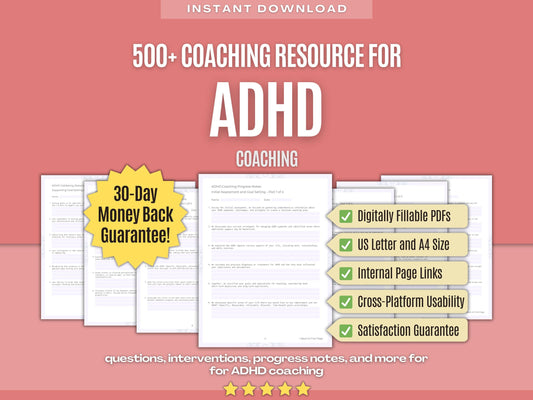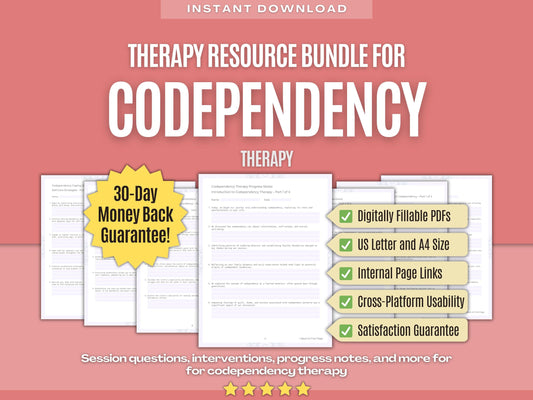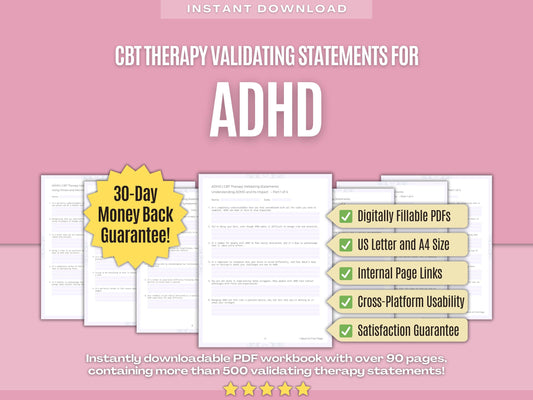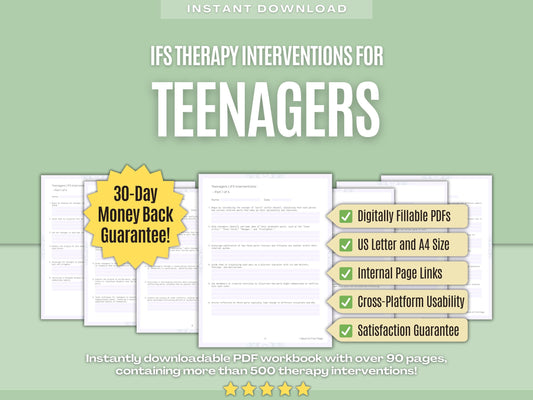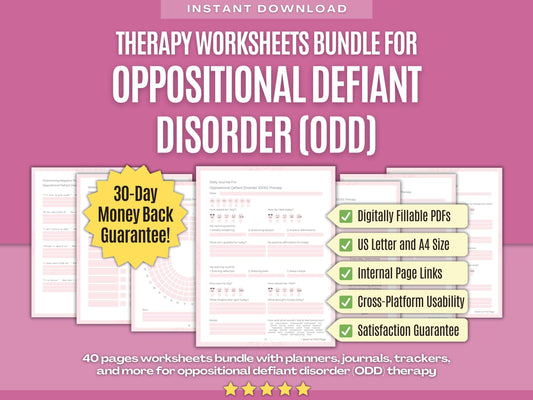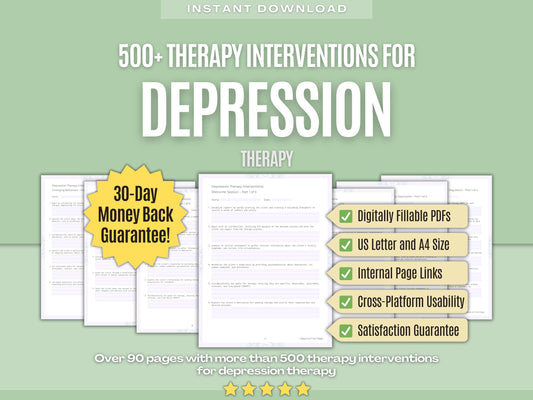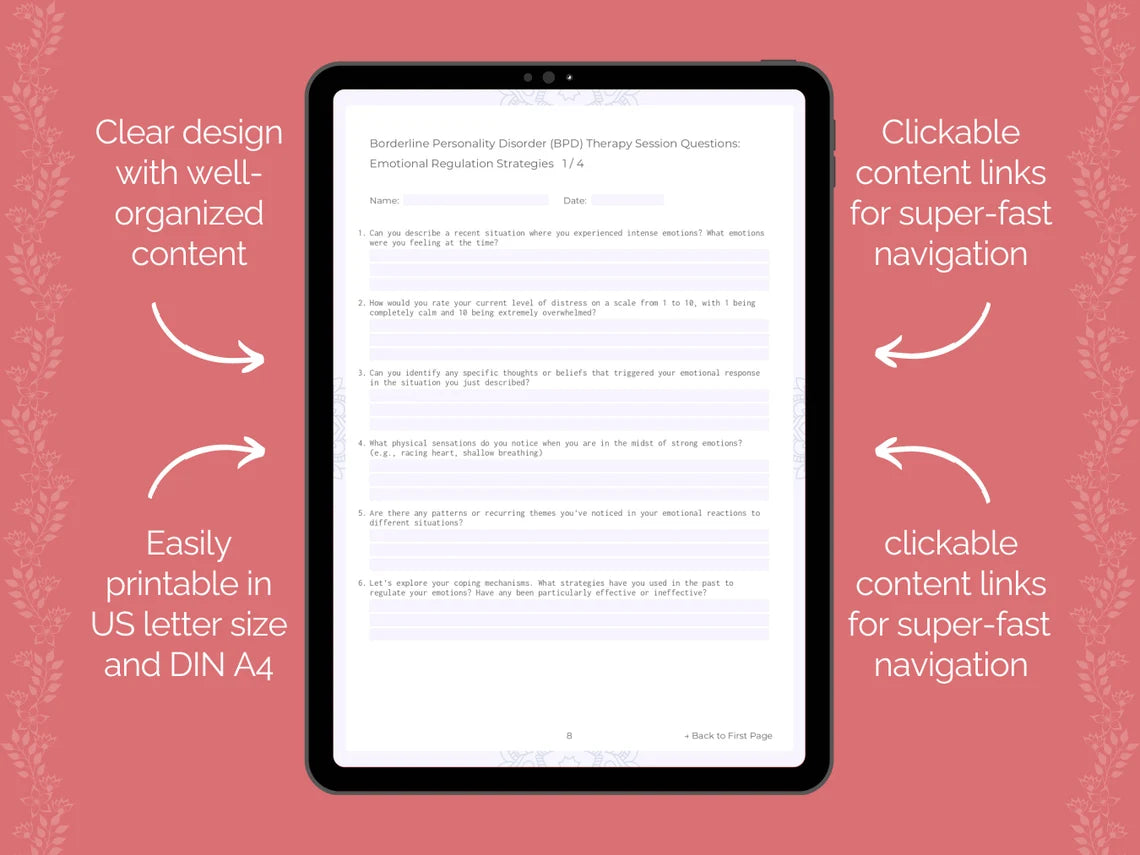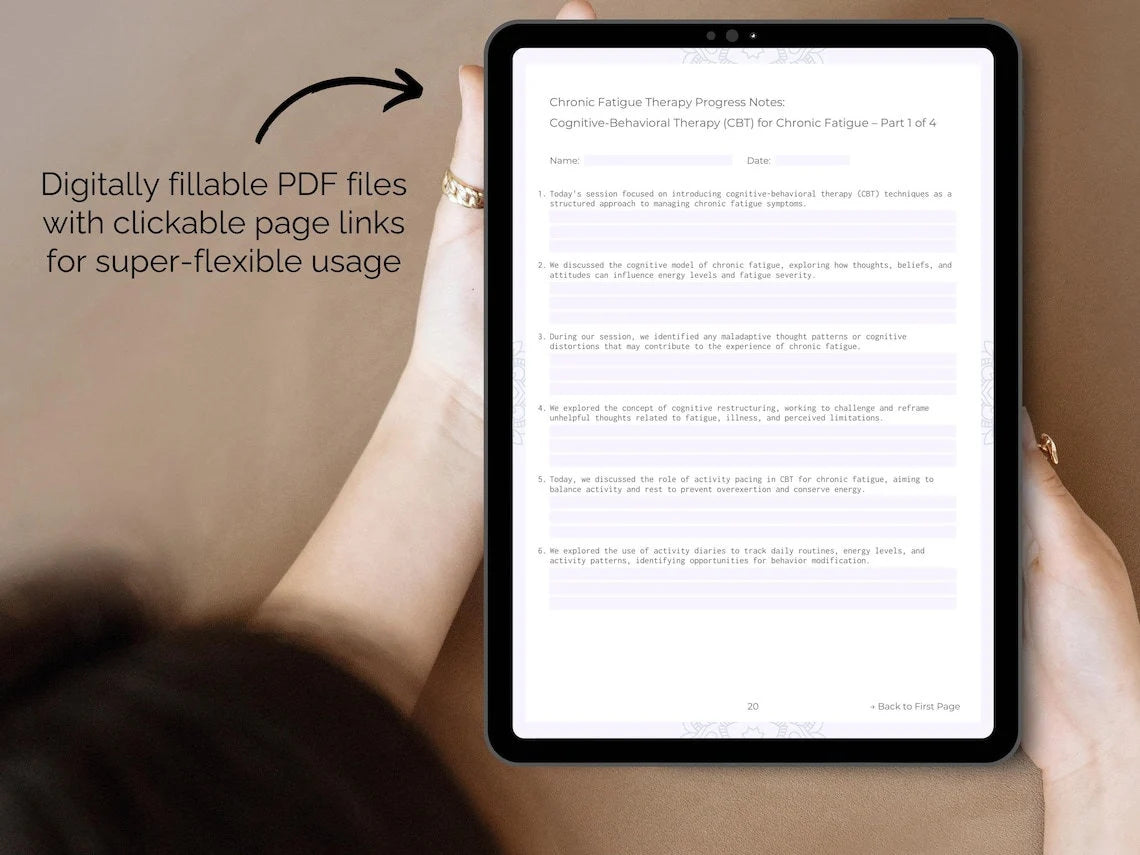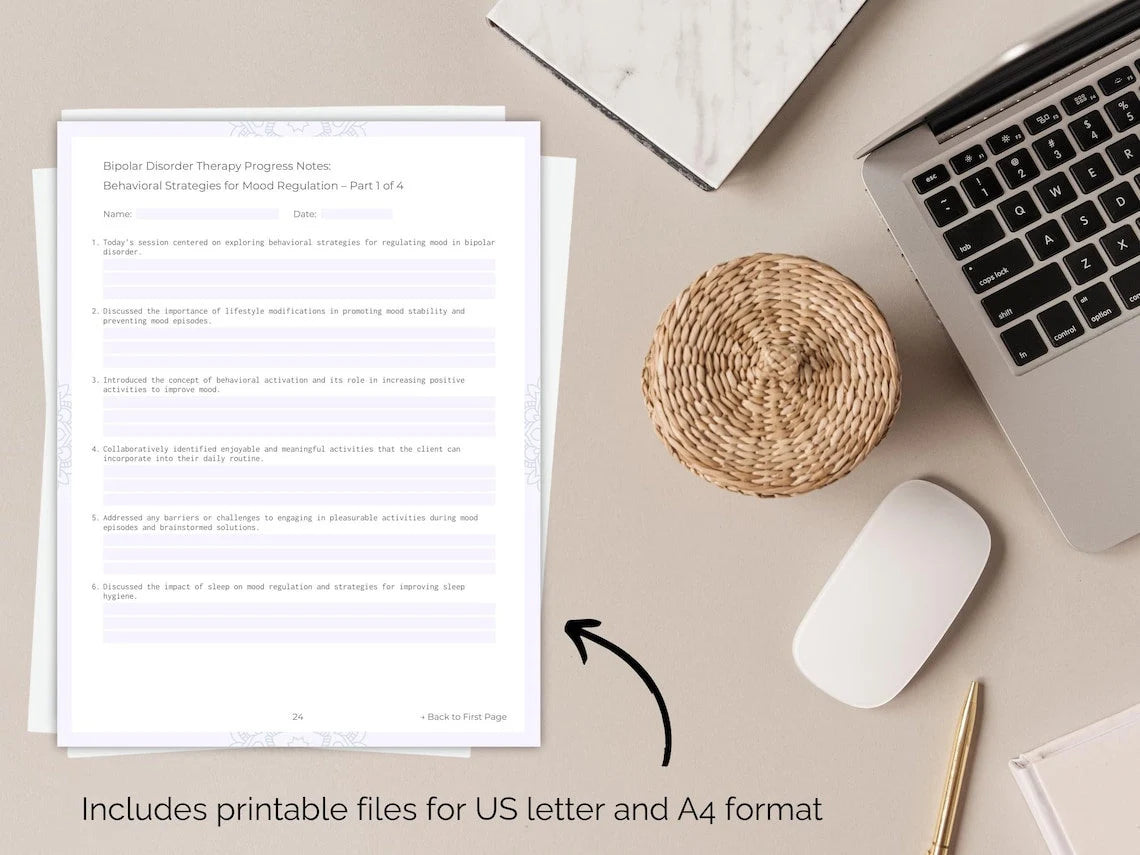Elevate Your Therapy and Guide Your Clients to Inner Healing with Our Anxiety Disorders Therapy Interventions! ✨
1. Starting Anxiety Therapy
- Establish a therapeutic alliance by creating a safe and trusting environment where the client feels comfortable sharing their experiences and emotions.
- Collaboratively identify specific goals for therapy, focusing on areas the client wishes to improve and outcomes they hope to achieve.
- Explore the client's past experiences and potential underlying factors contributing to the development and maintenance of their anxiety symptoms.
- Teach the client cognitive-behavioral strategies to challenge and reframe unhelpful thought patterns and beliefs associated with anxiety.
- Encourage the client to engage in regular physical activity and healthy lifestyle habits, as they can have a positive impact on anxiety symptoms.
- Introduce behavioral experiments to test the validity of anxious beliefs and build evidence for alternative, more adaptive responses.
- Provide psychoeducation on the use of relaxation exercises and stress management techniques to reduce overall arousal levels and promote a sense of calm.
- Explore the client's social support network and encourage them to seek support from friends, family, or support groups when needed.
- Incorporate elements of acceptance and commitment therapy (ACT) to help the client cultivate mindfulness skills and develop greater psychological flexibility in the face of anxiety.
- Introduce strategies for managing perfectionism and setting realistic expectations to reduce unnecessary stress and pressure.
- Collaborate with the client to develop a relapse prevention plan to anticipate and manage potential setbacks in the future.
2. Anxiety Disorders Education
- Begin by providing a comprehensive overview of anxiety disorders, including their prevalence, symptoms, and impact on daily functioning.
- Discuss the neurobiological basis of anxiety disorders, emphasizing the role of neurotransmitters, brain regions, and the fight-or-flight response.
- Introduce the concept of the anxiety cycle, illustrating how triggers, thoughts, physical sensations, and avoidance behaviors contribute to escalating anxiety.
- Discuss the role of environmental factors, such as stressors, trauma, and life transitions, in triggering or exacerbating anxiety symptoms.
- Explore the concept of comorbidity, highlighting the frequent co-occurrence of anxiety disorders with other mental health conditions such as depression or substance use disorders.
- Provide information on evidence-based treatments for anxiety disorders, including cognitive-behavioral therapy (CBT), exposure therapy, medication, and alternative therapies such as mindfulness-based interventions.
- Address common misconceptions about anxiety disorders, such as the belief that anxiety is a sign of weakness or that it cannot be effectively treated.
- Provide resources for further reading or support groups where clients can connect with others who share similar experiences.
- Introduce psychoeducation materials in various formats, such as handouts, videos, or interactive presentations, to accommodate different learning styles.
- Address the potential barriers to treatment engagement, such as financial constraints, logistical challenges, or cultural beliefs, and brainstorm solutions together.
- Offer guidance on managing anticipatory anxiety about treatment, including strategies for coping with uncertainty and setting realistic expectations.
3. Mindfulness for Anxiety
- Begin by introducing the concept of mindfulness and its potential benefits for managing anxiety symptoms, such as increased present-moment awareness and decreased reactivity to distressing thoughts and emotions.
- Practice mindful breathing exercises with the client, guiding them to observe the sensation of their breath entering and leaving their body without judgment.
- Introduce the concept of "anchoring" mindfulness techniques, such as focusing on a specific sensation or object in the present moment to ground oneself during moments of anxiety.
- Teach the client the STOP technique (Stop, Take a breath, Observe, Proceed mindfully) as a tool for interrupting anxious thoughts and responding more intentionally to challenging situations.
- Encourage the client to cultivate a nonjudgmental attitude towards their thoughts and feelings, fostering self-compassion and kindness towards themselves.
- Discuss the role of mindfulness in reducing rumination and breaking free from cycles of worry and anticipation about the future.
- Explore the connection between mindfulness and emotional regulation, highlighting how mindfulness practices can help individuals respond more skillfully to intense emotions.
- Discuss the potential challenges or barriers to maintaining a consistent mindfulness practice and brainstorm strategies to overcome them.
- Explore the client's experiences with mindfulness practice, including any changes they've noticed in their thoughts, emotions, or behaviors since beginning the intervention.
- Practice mindful self-compassion exercises with the client, helping them develop a nurturing and supportive inner dialogue during times of distress.
- Incorporate mindfulness into progressive exposure exercises for clients with specific phobias or anxiety disorders, helping them approach feared stimuli with greater awareness and equanimity.
4. Dialectical Behavior Therapy (DBT) for Anxiety
- Begin by introducing the foundational principles of Dialectical Behavior Therapy (DBT), including mindfulness, distress tolerance, emotion regulation, and interpersonal effectiveness.
- Practice mindfulness exercises such as observing thoughts without judgment, engaging in mindful breathing, or focusing attention on the sensations of the body to help the client ground themselves during moments of anxiety.
- Introduce emotion regulation strategies to help the client identify and manage intense emotions associated with anxiety, such as fear, worry, or panic.
- Explore the function of anxiety symptoms within the context of the client's emotional experiences and interpersonal relationships, using diary cards or behavioral chain analysis to identify triggers and maintainers of anxiety.
- Implement problem-solving techniques to help the client address stressors or challenges that contribute to their anxiety, emphasizing the importance of finding effective solutions and taking action to create change.
- Implement behavioral activation to increase engagement in pleasurable or meaningful activities that promote positive mood and reduce anxiety, using diary cards to track mood and activity levels.
- Encourage the client to use assertive communication techniques such as DEAR MAN (Describe, Express, Assert, Reinforce, Stay Mindful, Appear Confident, Negotiate) to effectively communicate their needs and preferences.
- Explore the connection between self-esteem and anxiety, using self-validation exercises to help the client recognize their strengths and build confidence in their ability to cope with anxiety.
- Implement behavior chain analysis to help the client identify the sequence of events leading up to anxious responses and develop alternative coping strategies to interrupt and change the pattern.
- Encourage the client to engage in self-care activities to promote overall well-being and resilience in the face of anxiety, such as practicing relaxation techniques, engaging in hobbies, or seeking social support.
- Explore the concept of dialectics in managing anxiety, helping the client balance acceptance and change-oriented strategies to cope effectively with distress.
5. Interpersonal Therapy (IPT) for Anxiety in Relationships
- Conducting an interpersonal inventory to assess the client's social support network and identify potential sources of relational stress contributing to their anxiety.
- Facilitating communication skills training to improve the client's ability to express their needs, set boundaries, and resolve conflicts effectively in relationships.
- Encouraging clients to identify and challenge maladaptive relationship patterns that contribute to their anxiety, such as codependency or excessive reassurance-seeking.
- Exploring the impact of past relationship experiences or traumas on the client's current anxiety symptoms and relational patterns.
- Using the "IPT Interpersonal Inventory" to assess the quality of the client's relationships and identify areas for improvement.
- Exploring cultural and societal influences on the client's relationships and how they may impact anxiety within those contexts.
- Utilizing the "interpersonal clock" to explore significant life events and transitions that may impact the client's relationships and anxiety levels.
- Encouraging clients to engage in activities that foster social connection and reduce feelings of isolation, such as joining clubs or support groups.
- Facilitating the development of assertiveness skills through role-playing exercises and real-life practice scenarios.
- Exploring attachment figures and their role in providing security and comfort during times of anxiety, including strategies for accessing support when needed.
- Encouraging clients to explore and challenge negative beliefs or fears about relationships that contribute to their anxiety symptoms.
6. Emotion-Focused Therapy (EFT) for Anxiety
- Begin by establishing a safe and supportive therapeutic relationship, emphasizing empathy and unconditional positive regard to create an environment conducive to emotional exploration and expression.
- Encourage the client to express their anxiety through various modalities such as writing, drawing, or role-playing, allowing them to externalize and process their emotions in a creative and nonverbal manner.
- Facilitate emotion-focused interventions such as two-chair dialogues or empty-chair exercises to help the client explore and reconcile conflicting emotions or inner conflicts contributing to their anxiety.
- Utilize experiential techniques such as guided imagery or visualization to help the client access and process deeply-held emotions related to their anxiety in a safe and controlled manner.
- Explore the client's relationship with their inner critic or saboteur, helping them develop self-compassion and self-soothing strategies to counteract self-critical thoughts and beliefs contributing to anxiety.
- Integrate emotion-focused interventions with cognitive restructuring techniques to help the client challenge and reframe maladaptive thought patterns and beliefs perpetuating their anxiety.
- Foster emotional expression and validation within the therapeutic relationship, offering empathic reflections and validating responses to the client's emotional experiences without judgment or criticism.
- Explore the client's attachment style and interpersonal patterns, recognizing how their relational dynamics and attachment needs may influence their experience and expression of anxiety.
- Use emotion-focused imagery rescripting techniques to help the client reframe and reinterpret past emotional experiences in a more adaptive and empowering light, fostering emotional healing and growth.
- Explore the role of emotional avoidance or suppression in perpetuating anxiety symptoms, helping the client develop acceptance-based strategies to experience and tolerate uncomfortable emotions.
- Encourage the client to practice emotional self-disclosure and vulnerability within and outside the therapy sessions, fostering authentic connections and supportive relationships that buffer against anxiety.
7. Psychodynamic Approaches for Deep Anxiety Issues
- Establish a therapeutic alliance built on trust and rapport, creating a safe space for the client to explore deep-seated anxieties within a psychodynamic framework.
- Explore the client's early attachment experiences and family dynamics, recognizing how relational patterns and early traumas may shape their current anxiety issues.
- Investigate the client's internalized object relations, exploring how their perceptions and expectations of self and others influence their anxiety symptoms and relational patterns.
- Utilize transference and countertransference dynamics as valuable sources of insight into the client's unconscious conflicts and relational patterns, exploring how they manifest within the therapeutic relationship.
- Investigate the client's psychic structure and ego defenses, exploring how their personality organization influences their capacity to manage anxiety and navigate interpersonal relationships.
- Utilize projective techniques such as drawings or storytelling to access the client's unconscious fantasies and anxieties, providing a window into their inner world.
- Explore the client's internalized critical voices and punitive superego, recognizing how self-criticism and perfectionism may exacerbate feelings of anxiety and inadequacy.
- Encourage the client to explore and express unconscious conflicts and desires related to power, control, and dependency, recognizing how these dynamics may contribute to anxiety symptoms.
- Explore the client's experiences of regression and fixation, recognizing how unresolved developmental conflicts may resurface during times of stress or anxiety.
- Encourage the client to explore and express their fantasies and wishes in a safe and nonjudgmental therapeutic space, recognizing how the expression of forbidden or taboo desires may alleviate anxiety.
- Utilize the therapeutic relationship as a vehicle for emotional containment and processing, providing a secure base from which the client can explore and work through deep anxiety issues.
8. Music Therapy for Soothing Anxiety
- Begin by establishing a therapeutic relationship with the client, creating a safe and supportive space for them to explore their anxiety through music.
- Explore the client's emotional responses to different types of music, recognizing how specific genres, tempos, and melodies may evoke feelings of relaxation, comfort, or emotional release.
- Encourage the client to engage in deep breathing exercises or progressive muscle relaxation while listening to calming music, synchronizing their breath and body movements with the rhythm and tempo of the music.
- Explore the client's personal associations and memories related to specific songs or musical pieces, recognizing how nostalgic or comforting music from their past may help alleviate anxiety in the present moment.
- Encourage the client to engage in music-based journaling or songwriting as a means of processing and expressing their thoughts, feelings, and experiences related to anxiety through creative self-expression.
- Utilize music therapy interventions such as Iso Principle or entrainment to help regulate the client's physiological arousal and promote relaxation through the rhythmic properties of music.
- Encourage the client to create personalized anxiety-relief playlists, selecting music tracks that they find particularly soothing or uplifting to listen to during moments of heightened stress or distress.
- Use music as a tool for emotional expression and release, inviting the client to create improvised musical compositions that reflect their feelings and experiences related to anxiety.
- Facilitate music-based relaxation exercises, such as guided progressive muscle relaxation paired with soft instrumental music, to help the client release tension and promote physical and mental relaxation.
- Encourage the client to engage in active music-making activities, such as playing an instrument or singing, as a means of self-expression and empowerment in managing their anxiety.
- Explore the client's experiences of flow and absorption in music-making activities, recognizing how immersive musical experiences may provide a sense of mastery and control over anxiety symptoms.
9. Concluding Anxiety Therapy Sessions
- Reflect on the client's progress and achievements throughout the therapy process, highlighting moments of growth, insight, and resilience in managing their anxiety.
- Explore the client's feelings and thoughts about ending therapy, acknowledging any ambivalence or apprehension they may have about transitioning out of therapy.
- Explore the client's support network and resources for ongoing support outside of therapy, including friends, family, support groups, and self-help resources.
- Validate the client's experience of anxiety as a normal and understandable response to stress and uncertainty, while also highlighting their progress in managing symptoms and improving quality of life.
- Explore the client's goals and aspirations for the future, focusing on areas of personal growth, relationships, work, and leisure activities.
- Provide psychoeducation about the nature of anxiety disorders, including common symptoms, triggers, and treatment options, to empower the client with knowledge and understanding.
- Discuss potential signs of relapse or recurrence of anxiety symptoms, and develop a plan for recognizing and addressing these warning signs if they arise in the future.
- Validate the client's experience of therapy as a valuable and meaningful process, regardless of specific outcomes or achievements, and express gratitude for their participation and dedication.
- Collaboratively review any homework assignments or action steps the client committed to during therapy, and celebrate progress and accomplishments in meeting these goals.
- Reflect on the therapeutic relationship and the client's experiences of connection, trust, and support within the therapeutic alliance.
- Explore the client's hopes and fears about life after therapy, and provide validation and support as they navigate the transition to greater independence and autonomy.
10. Final Reflections on Anxiety Management
- Encourage the client to reflect on their journey in managing anxiety, acknowledging the progress they have made and the challenges they have overcome.
- Reflect on the client's initial goals and aspirations for therapy, and assess how these goals have evolved or been achieved throughout the therapeutic process.
- Explore the client's experiences of setbacks or relapses in managing anxiety, and discuss strategies for learning from these experiences and moving forward with resilience.
- Reflect on the client's experiences of self-compassion and self-care in managing anxiety, and discuss ways to continue prioritizing their emotional well-being in daily life.
- Discuss the role of mindfulness and self-awareness in managing anxiety, and explore ways the client can continue practicing mindfulness techniques to stay grounded and present.
- Explore the client's values and priorities in life, and discuss how these values can inform their approach to managing anxiety and making choices that align with their overall well-being.
- Reflect on the therapeutic relationship and the client's experiences of connection, trust, and support within the therapeutic alliance.
- Encourage the client to celebrate their progress and accomplishments in managing anxiety, and to recognize the courage and resilience it takes to confront and overcome anxiety challenges.
- Explore the client's aspirations and goals for the future, including how they envision their life beyond therapy and what steps they can take to realize their dreams.
- Reflect on the client's experiences of using relaxation techniques and coping strategies to manage anxiety, and discuss how these tools can continue to be integrated into their daily life.
- Reflect on the client's experiences of connection and support within their community, and discuss how they can continue to foster meaningful relationships and seek support when needed.
We hope that our therapy interventions for Anxiety Disorders therapy will help you to elevate your therapy practice and guide your clients to inner healing! Do you need more therapy interventions for Anxiety Disorders therapy? Find them all in our Digital Workbook! Or do you have any questions or suggestions for us? Please feel free to contact us at any time!
